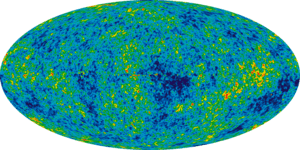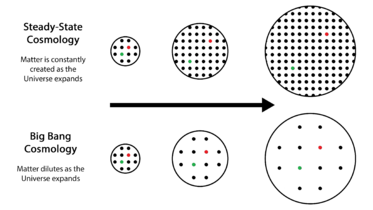Steady-state model facts for kids
| Physical cosmology | ||||||||||||||
 |
||||||||||||||
| Universe · Big Bang Age of the universe Timeline of the Big Bang Ultimate fate of the universe
|
||||||||||||||

The steady-state model is an old idea about how the universe works. It was a different way of thinking compared to the Big Bang theory. In the steady-state model, the universe is always expanding. But it also says that new matter is always being created. This means the universe always looks the same, no matter when or where you look. This idea is called the perfect cosmological principle.
From the 1940s to the 1960s, many scientists debated between the Big Bang and steady-state theories. Today, most cosmologists (scientists who study the universe) and astronomers do not believe in the steady-state model. This is because new observations and evidence support the Big Bang theory. For example, the Big Bang theory explains that the universe had a hot beginning and a certain age. The steady-state model does not predict this.
Contents
How the Idea Started
In the 13th century, a thinker named Siger of Brabant wrote about the universe being eternal. He thought there was no first human or first anything. This meant the universe had no beginning and would last forever. His ideas were later not approved by the pope.
Later, in the 1920s, Edwin Hubble observed that the universe was expanding. Scientists also realized that a universe that stays still, as Albert Einstein once thought, would not be stable. The modern Big Bang theory, first suggested by Father Georges Lemaître, says the universe has a specific age. It has changed over time by cooling down and expanding. Also, large structures like galaxies formed because of gravity.
On the other hand, the steady-state model said the universe expands but never changes its overall look. This means the universe has no beginning and no end. To keep the universe looking the same while expanding, new matter had to be created all the time. Important papers about this idea were published in 1948 by Hermann Bondi, Thomas Gold, and Fred Hoyle.
It is now known that Albert Einstein also thought about a steady-state model in 1931. This was many years before Hoyle, Bondi, and Gold. However, Einstein later gave up on the idea.
How Scientists Tested the Idea
Problems with the steady-state model started to appear in the 1950s and 1960s. Observations showed that the universe was actually changing.
Looking at Radio Sources
Scientists found bright radio sources, like quasars and radio galaxies, only very far away. This means they existed mostly in the distant past. This is because light from far away takes a long time to reach us. The Big Bang theory predicted this. But the steady-state model said these objects should be found everywhere, even close to our own galaxy. By 1961, studies of these radio sources showed that the steady-state model was likely wrong.
The Cosmic Microwave Background
For most scientists, the steady-state model was disproven in 1964. This happened with the discovery of the cosmic microwave background (CMB) radiation. The Big Bang theory had predicted this radiation. The steady-state model tried to explain the CMB as light from old stars scattered by dust.
However, the CMB radiation is very even in all directions. This makes it hard to explain if it came from many scattered sources. Also, the CMB radiation looks almost exactly like light from a perfect black body. This means it came from a very hot, dense state, which fits the Big Bang theory. It would be very difficult for dust clumps at different temperatures to create such a perfect signal.
After this discovery, the Big Bang theory became the most accepted explanation for the universe's origin. Most scientific papers now use the Big Bang as the main idea for understanding the universe.
The Universe's Appearance
One main idea of the steady-state model is the cosmological principle. This principle says that our place in the universe is not special. On a very large scale, the universe looks the same in all directions (this is called isotropy). It also looks the same from every location (this is called homogeneity). However, recent findings suggest that the universe might not be perfectly isotropic or homogeneous.
Is the Universe the Same in All Directions?
Evidence from galaxy clusters, quasars, and type Ia supernovae suggests that the universe is not perfectly the same in all directions on large scales.
Data from the Planck Mission shows differences in the cosmic microwave background (CMB). One difference is in average temperature. Another is in how much the density changes. The European Space Agency says these differences in the CMB are real and important.
In 1967, Dennis Sciama predicted that the CMB would show a "dipole anisotropy." This means it would be slightly warmer in one direction and cooler in the opposite. Recent studies show that our motion compared to distant galaxies and quasars is different from our motion compared to the CMB. This goes against the idea that the universe looks the same in all directions.
Is the Universe the Same Everywhere?
Many very large structures have been found in the universe. Some scientists think these structures are too big to fit the idea of a perfectly homogeneous universe. These include:
- The Clowes–Campusano LQG, found in 1991, which is about 580 million light-years long.
- The Sloan Great Wall, found in 2003, about 423 million light-years long.
- The Huge-LQG, found in 2012, which is much larger than expected.
- The Hercules–Corona Borealis Great Wall, found in 2013, which is incredibly long (2 to 3 billion light-years).
- The Giant Arc, found in 2021, about 1 billion light-years long.
However, other scientists believe that these large structures do not necessarily mean the universe is not homogeneous on the very largest scales.
A Newer Version of the Idea
A newer version of the steady-state idea, called quasi-steady-state cosmology (QSS), was suggested in 1993. It was proposed by Fred Hoyle, Geoffrey Burbidge, and Jayant V. Narlikar. This model suggests that small "mini-creation events" or "little bangs" happen over time in the universe.
After scientists observed that the universe's expansion is speeding up, more changes were made to this model. However, astrophysicist Ned Wright and other mainstream scientists have pointed out problems with the QSS model. These problems show that it does not fully match observations of the universe.
See also
- Non-standard cosmology
- Copernican principle
- Large scale structure of the cosmos
- Metric expansion of space
 In Spanish: Teoría del estado estacionario para niños
In Spanish: Teoría del estado estacionario para niños

